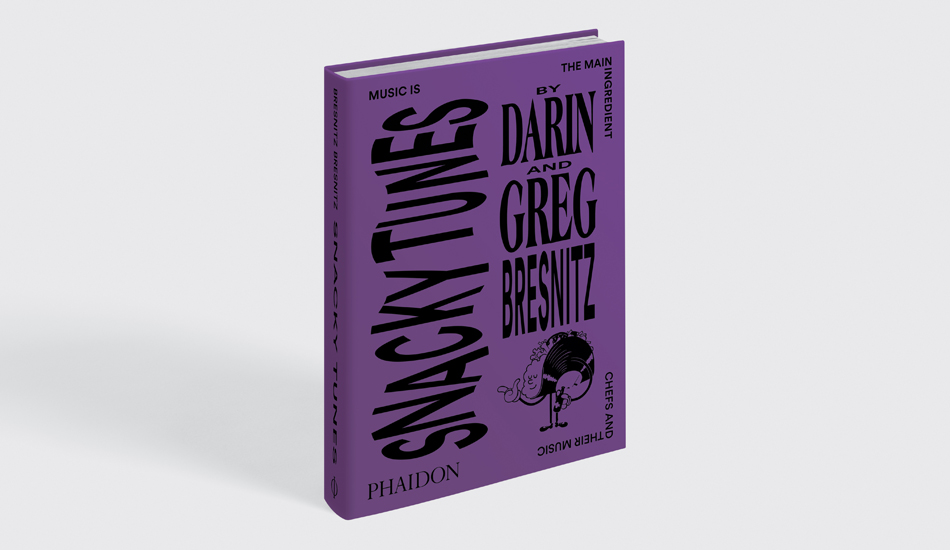
INTERVIEW: Snacky Tunes on DJing, the rise of the cult chef and why the best food record ever is only 17 seconds long
Darin and Greg Bresnitz, the brothers behind the hit podcast and new Phaidon book, talk us through their climb to the top of the food chain and which culinary masters and recording artist they’ve grown to admire
Greg and Darin Bresnitz’s podcast and accompanying publication might be called Snacky Tunes, but their pairing of music and food isn’t a bite sized affair. The new book is an engrossing collection of personal stories from over 75 of the world's most acclaimed chefs, detailing the ways in which music has been a constant presence, helping these culinary greats define themselves individually, while also opening gateways to understanding their cultures and igniting the creativity behind their work.
Just like the chefs interviewed, Darin and Greg have cultivated a life-long love of the musical and culinary arts, ever since they were kids, growing up in Philadelphia. In this Q&A the boys talk about their childhood food, how they flipped DJing into a gastronomic career, and the new great works - from the kitchen and from recording artists - they came across in the making of their new book.
If you guys had to put together a playlist from the Bresnitz family household when you were growing up, what would be on it and what would have been cooking in the kitchen? [Darin] The duties of making the playlist and cooking in the kitchen, respectively, would have fallen to dad and mom. Dad was the guy who controlled the stereo in the house and mom controlled the kitchen, although the roles were really intertwined. I believe they really fed off each other's music collections and cooking. This would be dad's playlist: Carole King, The Pretenders, Talking Heads, Alanis Morrisette, Ani DiFranco, Patti Smith, Fleetwood Mac, Eric Clapton, Van Morrison, Steve Winwood, Hall and Oates, Sting, The Beatles, Al Jarreau, Prince,Queen, Sade, Madonna, Billy Ocean, Neil Young.
And for mom, it could be a variety of things. She really did push the boundaries of what would be considered home cooking in the 90s. She would make everything from French braised short ribs to Chinese spiced duck to rabbit stew. But a typical night in the kitchen at home, usually consisted of a garden salad, a roast chicken with fresh vegetables and some rice, and then a little bit of ice cream for dessert (or grandma’s nut cake / chocolate cake). We were under the impression that this is how most people ate, and it wasn’t until we found out much later that mom was styling her meals after three-course European type fare. So we felt very lucky eating.
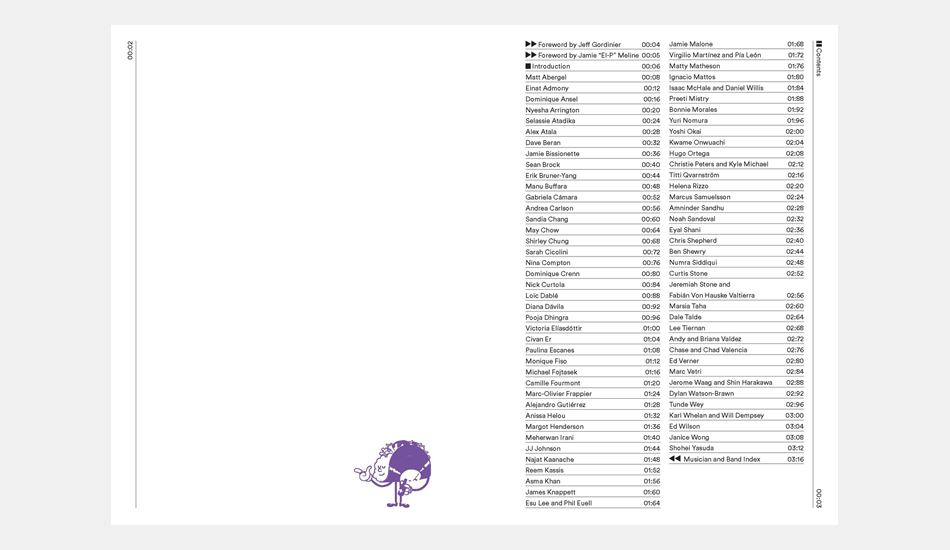
Snacky Tunes owes its origins to your DJ connections. How did you guys start out DJing? And what is the best food related party record ever?
[Greg] I started deejaying at the college radio station, first at Boston University and then again at KWVA-FM at the University of Oregon, where I became co-music director. I had a show that was called, “Let the Kids Have Their Rock and Roll.” My name was D.J. Let the Kids Have the Rock and Roll, but then transferred that name to a show. I got my DJ name, Never Forget, during that time and started playing at parties. There was the rise of bloghouse and the electroclash dance punk scene coming out of Williamsburg while I was still at the University of Oregon. My roommate at the time and I kind of collected all the music that was coming out and decided to throw a party. The party was called “Finger on the Pulse,” which was from a Bloc Party song “Like Eating Glass” off of their first record, Silent Alarm.
I knew I was going to move to Williamsburg afterward and started looking for D.J. nights. I was looking at Craigslist where you could essentially sign up for a free slot. You would bring all your gear and it'd be four different people, who would each get an hour set. Whoever was the best that day had a second hour, a hundred bucks and a bar tab. I did not think that was going to get us very far. So we started looking for a space, that is how we met Don Peavy [chef who has cooked for Madonna and the Obamas]. Darin can finish the story.
My pick for the best food-related party record would be Otis Redding’s classic, “Cigarettes and Coffee,” because it makes me think of the after party. The song makes me think of the morning after a long night out when you wake up with someone you love and you are having your morning rituals, contemplating life and thinking about the future.
[Darin] We both started deejaying individually. Greg was going to school in Eugene, OR, and I was living in Austin. Greg started deejaying bloghouse and electro, this was 2003 /2004, and I was doing more of a soul, punk, Britpop type of vibe in Austin. After we both moved to Brooklyn, we wound up at this Italian speakeasy called the Graham Lounge, which we had found off of a Craigslist post, which was posted by the legendary Don Peavey. It was there with our good friend PJ, a.k.a. D.J. Balls Deep, that we started “Finger on the Pulse,” which was our moniker when we did all of our deejaying or events. We started doing food events with our “Barbecue Blowout” series, which was about bringing high-end chefs into Williamsburg and pairing them with a D.J. We ran those parties for about 10 years.
Having this weekend relationship with different people, and then also turning that relationship into a relationship during the working week, really helped us make these connections and shortened how long it took to move things forward. We were able to hang out at a party with them and create these great memories on the weekends, then turn that into something more concrete during the weekdays. We would always meet up over a meal, hanging out with these great artists and makers with great food in the mix. So we were always on the hunt to find cool places to eat all around Manhattan’s Lower East Side and in Brooklyn.
I would say the greatest food party record of all time would be the Descendents, “I Like Food”. I mean, just clocking in at 17 seconds total, it really sums up the feeling when you're sort of hungry and you want a good meal. It's a ripper.
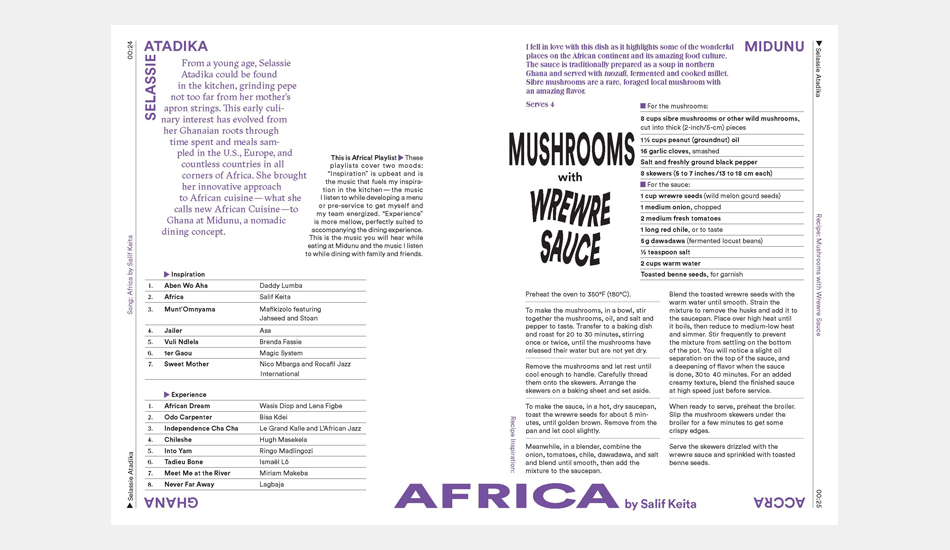
How did chefs attain such a high status in our culture? I think you guys believe at the 2008 economic downturn played a part? [Darin] It's interesting. The actual time when chefs turned into such popular culture figures was earlier than 2008. I really believe The Naked Chef, the original Iron Chef and some of these cooking shows in the early 2000s really started to shift the mentality. I would also say the publishing of Anthony Bourdain’s seminal memoir, Kitchen Confidential, in 2000 had people starting to look at chefs in a new light. Professional cooking was like this punk rock, DIY, artist pursuit.
By 2008/ 2009, with the economic downturn mixed with social media platforms, namely Twitter, really led to the rise of the food truck. I think the food truck’s importance, as a way of helping to save and refresh the food industry, also made chefs / food a lot more accessible to the public. It meant you could literally talk to chefs since they weren’t out of sight in some windowless restaurant kitchen, and chefs also hit this new cult status. Obviously, Roy Choi with his Kogi truck is a national / international story, and chefs obtained this new sort of cultural status through food and through this vision.
Then once it tipped over into the mainstream people became obsessed. People blogging about food and when Instagram took off, people were taking photos of food and sharing them. Then you have the rise of food tourism and things like that. You add up all of these factors and that’s part of why we are where we’re at today culturally with food, especially in America.
[Greg] Chefs and dining are part of an attainable culture. Partying like a rockstar and being able to engage with a rockstar was just always nearly impossible. The stage itself creates both a physical and mental platform and barrier for fans. Your hero is on a pedestal, and you’re not allowed to be on it with them.
When it came to chefs, the ability to be in the same room and to be so close to that talent was almost instantaneous. You knew where to find them, and knew where they were going to be every night. Chefs were doing things that were just as creative and transformative as musicians. They touched people's souls, elevated cuisine, elevated humanity, elevated culture and allowed for people to interact with them.
They're also really approachable. I mean, we're not talking about a profession that has always been godlike. Musicians, artists, etc., have always existed on that plane, and chefs up until 2008, were a bunch of ne'er do wells who were seen as another side of the culture. I think even chefs themselves were surprised when things really began to take off.
People had accessibility and the ability to touch chefs, and also had the ability to experience their work so intimately and regularly, which leads to forming actual personal connections. It wasn't like with music where it was, “Oh, [insert your favourite band] are coming to town for one night only, and you can only see this one show.” With chefs and their restaurants, you have something that can become regular and even habitual.
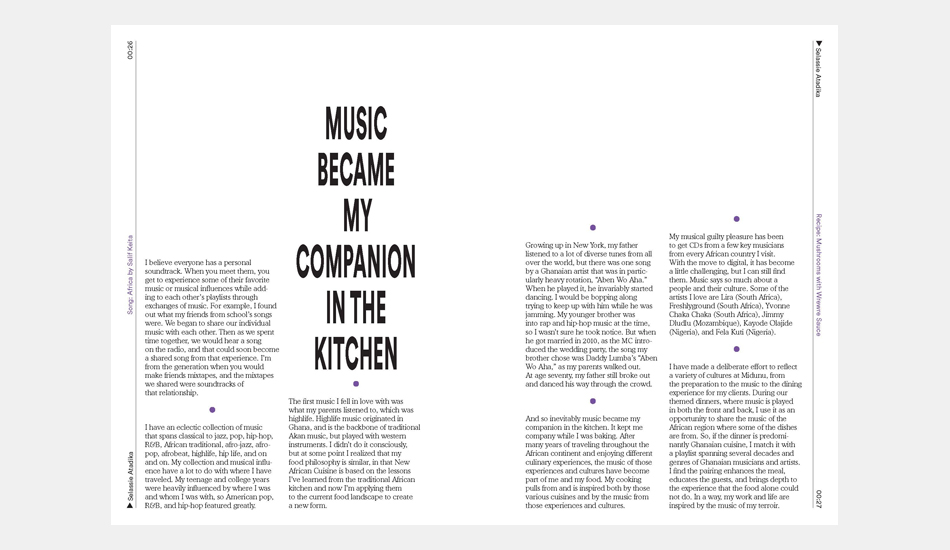
The selection of chefs in the book is hugely varied in terms of geography, backgrounds and tastes. How did you choose them? [Greg] First and foremost, the most important editorial criterion was that they were music fans. Full stop. This book could not have been done unless you loved music. We had some chefs early on who told us that, “You know, thank you for this, but music is not really a passion of mine, and I don't think I could participate.” So before all else we had to make sure they were music fans and then everything else went from there.
[Darin] The diversity in the book–gender, location and racial background–was intentional from the get-go. We wanted this book to do its best to represent the entire world when it came to food and music, because it is important to show what makes us different isn't that much, and we share a lot of the same through lines, like the chef's creative process / passion. There's a real beauty in that. You know, we found similar family stories across the board and other influences from people who never met.
We originally agreed to do 50 chefs or 50 different restaurants and entries, but for us to really hit our goals and tell the diverse stories we wanted, we ended up getting 77 entries and 86 chefs / restaurateurs. We believe having that amount of chefs really shows the wide variety of musical tastes, food and passion throughout the world.
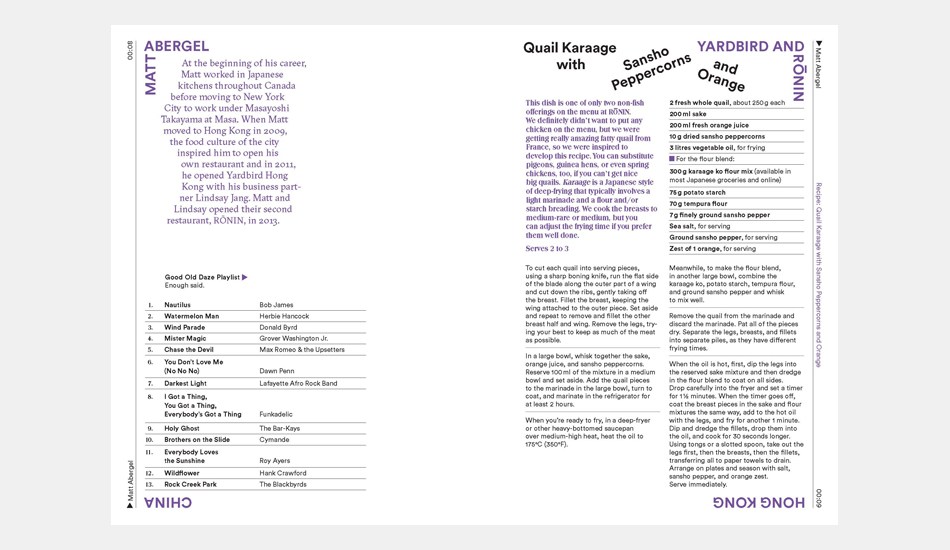
Who were you pleased to get and which interview surprised you the most? And what new chefs did you come across in the making of the book? [Darin] The book is a mix of friends, professional colleagues, lots of research, cold emails and calls. There are a couple of chefs we absolutely knew that we wanted to have in this book from the very beginning. We interviewed Dominique Crenn a few years back and her passion for the arts and music was transfixing. She was just someone we knew would have beautiful stories to tell. We also knew Marc Vetri, who's from our hometown of Philadelphia, who we've had on the show before. He was the first chef to play guitar on the show and had to be in the book. He loves music, and actually originally set out to become a musician.
Someone like Alex Atala, down in São Paulo, his love for music is legendary, and even though he's running a Michelin-starred restaurant you still feel that DIY punk approach to it. For Nyesha Arrington, who we absolutely love from California, music is just part of her existence. She grew up in an artist's family and she was just a perfect pick for the book.
The research part was a lot of fun. We went digging into different parts of the world to find chefs who shared the same passion for music. Selassie Atadika, who runs Midunu in Ghana, is an incredible chef, and also shared a wealth of knowledge about African music. Her stories and food are really beautiful and a perfect complement to the entire book. Ben Shewry, who we knew through social media and other chef colleagues, gave two of the best stories in the entire book, and we still chat weekly. It’s been nice to make some new friends and learn about new artists through this process.
[Greg] I was happy with every chef who said yes; we really wanted to make sure that we had a diverse round of voices. With every chef we reached out to, we held our breath and just hoped. I think we agonized over everyone in the same way because everyone played a role in the world that we were building. We need everyone who's in this book to be in here because they each brought value and balance to all the other opinions. It was really important to us to ensure we had a well-rounded, diverse set of voices in order to make the book that we wanted to make.
I don't believe there was one interview that surprised me more than another. What surprised me about the interviews was how deep and how real everyone allowed us to get with them. Most of these chefs are so media trained. When you ask them the same questions, you get the same answers. It seems like music was able to unlock something from inside of them, and it compelled them to speak deeply, humanely and reverently about something that is so personal to them. I truly believe music is their first love.
Everyone spoke from the heart and really gave us something special. If I did have to pick someone, Najat Kaanache has been my favourite discovery and someone I consider as a friend now due to going through the process. We were absolute strangers. She came to me through a friend of a friend's suggestion. Learning about her, her story, her food, her struggle and her positive approach to life has been incredible. Her optimism just really makes me happy to have done this project, if only because I got to know her.
What are your favourite culinary and musical discoveries you came across? [Greg] My favourite culinary discovery has been Anissa Helou’s ”Lamb Tagine with Cauliflower.” It's just the perfect dish. I had never really cooked with lamb before. So it was a new experience for me. And what I love about her playlist is that it's just a mix of where she's from and the music that she loves. In the middle of it, there is an hour long track called “Laylat Hob” by Umm Kulthum, an Egyptian singer, songwriter and film actress active from the 1920s to the 1970s who was given the honorific title Kawkab al-Sharq (كوكب الشرق, 'Planet of the East'). The long track just kind of came in as a surprise while I was prepping the meal, it was perfect. It’s a live track so there is cheering and applause, which gave me encouragement while cooking something new.
[Darin] Manu Buffara really turned me onto a lot of great Brazilian music I had never heard of, like Céu. The amount of music in this book humbled me to the core about how little I really know about different artists, songs, etc. There are so many incredible auditory tangents in these pages that it will be a long time before I need any new suggestions. As for food, Kwame Onwuachi’s “Black Cow,” braised boneless short ribs, used chicken feet as part of the flavouring ingredients. I had never used chicken feet in this way before and they imparted so much flavour into the beef and sauce, truly a revelation.
To get greater detail on the records mentioned, as well as the recipes for the dishes Greg and Darin both love, order a copy of Snacky Tunes here.
